A Guide to Celebrating
Hari Saraswati
with Gamelan Sekar Jaya
Words for the Non-Balinese Community
You are not required to participate in the ceremony. The important thing is - if you don’t want to, please stay back and be respectful.
If you participate, it should be from your heart that you want to do it. When you come to the padma (garden shrine), you should want to be there. Don’t think about other things, be in the moment in the place where you are. Yang penting jujur: what’s important is truth and honesty.
ceremony guide
This written in quotation will be said out loud by the ceremony leader or priest. These words can help guide the congregation move through the process synchronously.
Purification
Congregation members should gather sitting on the ground cross-legged or kneeling facing the padma. Before engaging in prayer the congregation members must cleanse themselves: first with tirta (holy water) and then with the dupa (smoke from the incense).
“Asana”
When this is said, those sitting are queued to open their hands with palms facing up. They can be rested on cross-legged knees or in the air for those sitting with legs folded.
“Pranayama”
When this is said, put your hands to your chest, left gently over the right, thumbs touching and hands open on top of each other. Fix your breathing, take deep breaths, breathe through your stomach with your diaphragm.
“Kara Sudana”
Purify your hands over the incense smoke. Put both hands on top of each other, open and facing upwards over the smoke. Close your eyes and recite the mantras, changing which hand is on top starting with your right hand. This is done to purify both hands.
Sembahyang / Prayer
Trisandya
After changing hand positions: moving the hands to your chest, right over left and with fighters pinched to form a lotus bud shape. Everyone can begin reciting the gayatri mantram. If you don’t know the mantram, you can just listen.
Panca Sembah
After reciting the trisandya together, bring the spirit and body together. Concentrate to be ready for praise/worship of god and spirits.
Tangan puyung (bring your hands together to your forehead without flowers or incense). Mehuningan (clarification of the thoughts, preparation).
Bunga putih (bring your hands together to your forehead with white or yellow flowers)
Kepada surya/prayer toward matahari/god/heaven “sumber kehidupan.” Acknowledge this greater entity as a witness to the prayer and give thanks.Panca warna atau kwangen (bring your hands together to your forehead with multi-color flowers or a kwangen cone-shaped offering)
Ibu pertiwi / Betara Betari (prayer toward mother earth, all angels and spirits). Express gratitude for your rakhmat (angel that helps you, blessings, strength), for food, shelter, etc. This is also to focus on the purpose of the day, Hari Saraswati.Bunga campur (bring your hands together to your forehead with mixed/multi-colored flowers)
Toward your ancestors, your own spirit, your pura in Bali, your family. Ask for blessings. Ngacep: It’s personal. For your community, your people.Puyung (kosong. Bring your empty palms together to your forehead) “Om santi santi santi”
Asking for blessings, express gratitude. When you are finished with your flowers, you can put them in your hair.
Tirta dan Bija
Someone, (usually a priest/ceremony leader, but it can be a member of the prayer congregation) gets up and distributes the holy water and rice to every member of the congregation. This person can also help guide anyone receiving who may not be familiar with the sequence.
- Tirta (holy water) doused three times over the person's head. This person should lean their heads slightly forward in order to receive this and keep their hands open with palms facing up in front of them.
- The person receiving the tirta then drinks the water three times. First they should put their hand together to form a cup which will be filled by the priest after every sip. After the third sip, the person’s cupped hands will receive tirta a fourth time which should be washed over their head.
- Bija (rice is food as a symbol of god): Raw rice grains soaked in holy water, often stored in a shallow bowl or plate underneath the holy water container.
After dousing tirta, the priest will lift the cup to offer the plate of bija underneath. The person receiving should reach into the plate themselves to take pinches of rice three times. The first two times, rice should be placed on their foreheads between their eyebrows and on their chest. The last bit of rice taken should be the best three pieces of rice (don’t overthink it) and are to be eaten and swallowed.
You can put the rice on other places too but the most important is on your forehead and your chest beneath your throat. Don’t throw it away! If you take it from the plate, then use it on your body.
After this, the ceremony will finish and everyone can enjoy time with the community. Thank you for participating!


